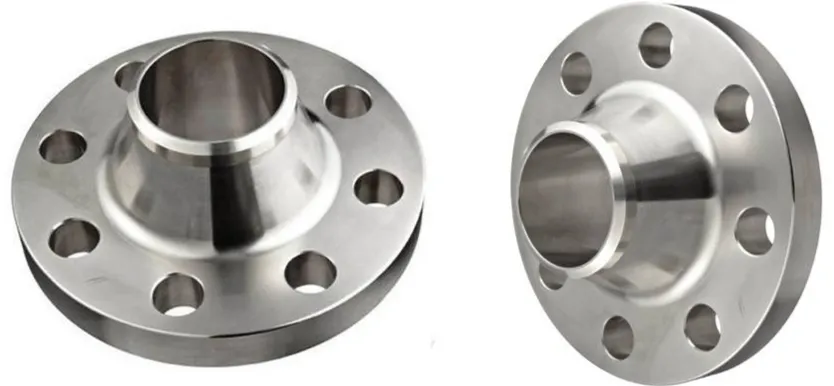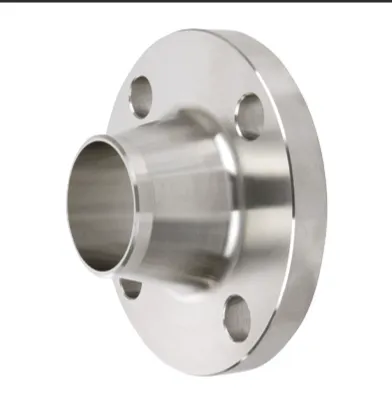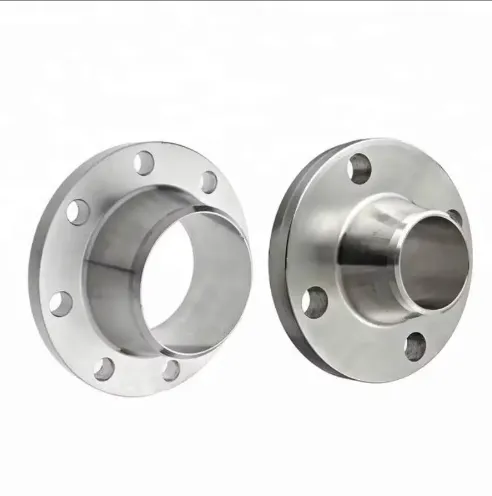General Introduction
ASME B16.5 is a standard developed by the American Society of Mechanical Engineers (ASME) that deals with pipe flanges and flanged fittings. The Flat Face Weld Neck Flange is designed and manufactured in accordance with this standard. It's a crucial component in piping systems, used to connect pipes, valves, pumps, and other equipment, enabling easy installation, disassembly, and maintenance.
Design and Structure
Weld Neck: It features a long tapered neck which is welded to the pipe. This design offers better stress distribution and enhances resistance to fatigue and thermal cycling, making the connection between the flange and the pipe more reliable. It's suitable for high-temperature, high-pressure applications and those with large pressure or temperature fluctuations.
Flat Face: The sealing surface of the flange is flat. When connected with a mating flange, a gasket is used to achieve sealing. This flat design is simple, convenient for installation and maintenance, and has a relatively low requirement for installation accuracy. It's applicable in situations where the medium is mild and the pressure is not too high.
Dimensions and Specifications
Nominal Diameter: Usually available in sizes ranging from 1/2 inch to 24 inches.
Materials
Carbon Steel: Materials like ASTM A105 are commonly used. Carbon steel has good strength and cost-effectiveness, meeting the requirements of general working conditions. It's widely used in pipelines carrying ordinary media in industries such as petroleum, chemical engineering, and power.
Stainless Steel: Grades such as 304 and 316 are often employed. Stainless steel offers excellent corrosion resistance, making it suitable for transporting corrosive media, especially in industries like chemical engineering, food and beverage, and pharmaceuticals where high corrosion resistance is required.
Alloy Steel: In high-temperature, high-pressure, or special media environments, alloy steel materials may be selected to provide higher strength, heat resistance, and corrosion resistance.
Pressure-Temperature Ratings
Pressure Ratings: According to ASME B16.5, the pressure ratings of flat face weld neck flanges include Class 150, 300, 400, 600, 900, 1500, 2500, etc. Flanges of different pressure ratings differ in dimensions, thickness, and material properties to adapt to different working pressure requirements.
Temperature Limits: The allowable temperature range of the flange depends on the material. Carbon steel flanges are generally suitable for medium and low-temperature environments, while stainless steel flanges can withstand higher temperatures, and alloy steel flanges can operate under extreme high or low temperatures. When in use, it's necessary to refer to the pressure-temperature rating table in the standard to determine the allowable operating temperature range based on the specific material and pressure rating.
Applications
Petrochemical Industry: It is widely used in process pipelines of petroleum refining and chemical production plants to connect pipelines transporting various petroleum products, chemical raw materials, and intermediate products, such as crude oil transportation pipelines, refined oil pipelines, and chemical material pipelines.
Power Industry: It is commonly used in pipelines of power plants, including main steam pipelines, condensate pipelines, and circulating water pipelines in the steam-water system and cooling water system.
Other Industries: It is also used in fluid transportation pipeline systems in industries such as papermaking, pharmaceuticals, and food and beverage to connect pipes and equipment, meeting process requirements and safety standards.
-
Cangzhou Yulong Steel Co., Ltd.
-
Phone:
+86 13303177267 -
Email:
admin@ylsteelfittings.com
- English
- Arabic
- Italian
- Spanish
- Portuguese
- German
- kazakh
- Persian
- Greek
- French
- Russian
- Polish
- Thai
- Indonesian
- Vietnamese
- Zulu
- Korean
- Uzbek
- Hindi
- Serbian
- Malay
- Ukrainian
- Gujarati
- Haitian Creole
- hausa
- hawaiian
- Hebrew
- Miao
- Hungarian
- Icelandic
- igbo
- irish
- Japanese
- Javanese
- Kannada
- Khmer
- Rwandese
- Afrikaans
- Albanian
- Amharic
- Armenian
- Azerbaijani
- Basque
- Belarusian
- Bengali
- Bosnian
- Bulgarian
- Catalan
- Cebuano
- China
- China (Taiwan)
- Corsican
- Croatian
- Czech
- Danish
- Esperanto
- Estonian
- Finnish
- Frisian
- Galician
- Georgian
- Kurdish
- Kyrgyz
- Lao
- Latin
- Latvian
- Lithuanian
- Luxembourgish
- Macedonian
- Malgashi
- Malayalam
- Maltese
- Maori
- Marathi
- Mongolian
- Myanmar
- Nepali
- Norwegian
- Norwegian
- Occitan
- Pashto
- Dutch
- Punjabi
- Romanian
- Samoan
- Scottish Gaelic
- Sesotho
- Shona
- Sindhi
- Sinhala
- Slovak
- Slovenian
- Somali
- Sundanese
- Swahili
- Swedish
- Tagalog
- Tajik
- Tamil
- Tatar
- Telugu
- Turkish
- Turkmen
- Urdu
- Uighur
- Welsh
- Bantu
- Yiddish
- Yoruba

Write your message here and send it to us
Related News
-
Jul . 23, 2025Space-Saving Connection Mastery: How 1/2 Pipe Nipple’s 50mm Short Design Solves Dense Piping Installation Challenges?In the labyrinth of industrial machinery, where pipes weave through 200mm-wide gaps and every millimeter counts, the battle against cramped spaces often stalls projects.
-
Jul . 23, 2025Shale Gas Extraction Impact Resistance: How ASME B16.47 Flange's Hub-Thickened Design Passes Seismic Testing?In the high-stakes realm of shale gas extraction, where seismic activity and operational vibrations threaten pipeline integrity, the ASME B16.47 flange emerges as a critical safeguard.
















